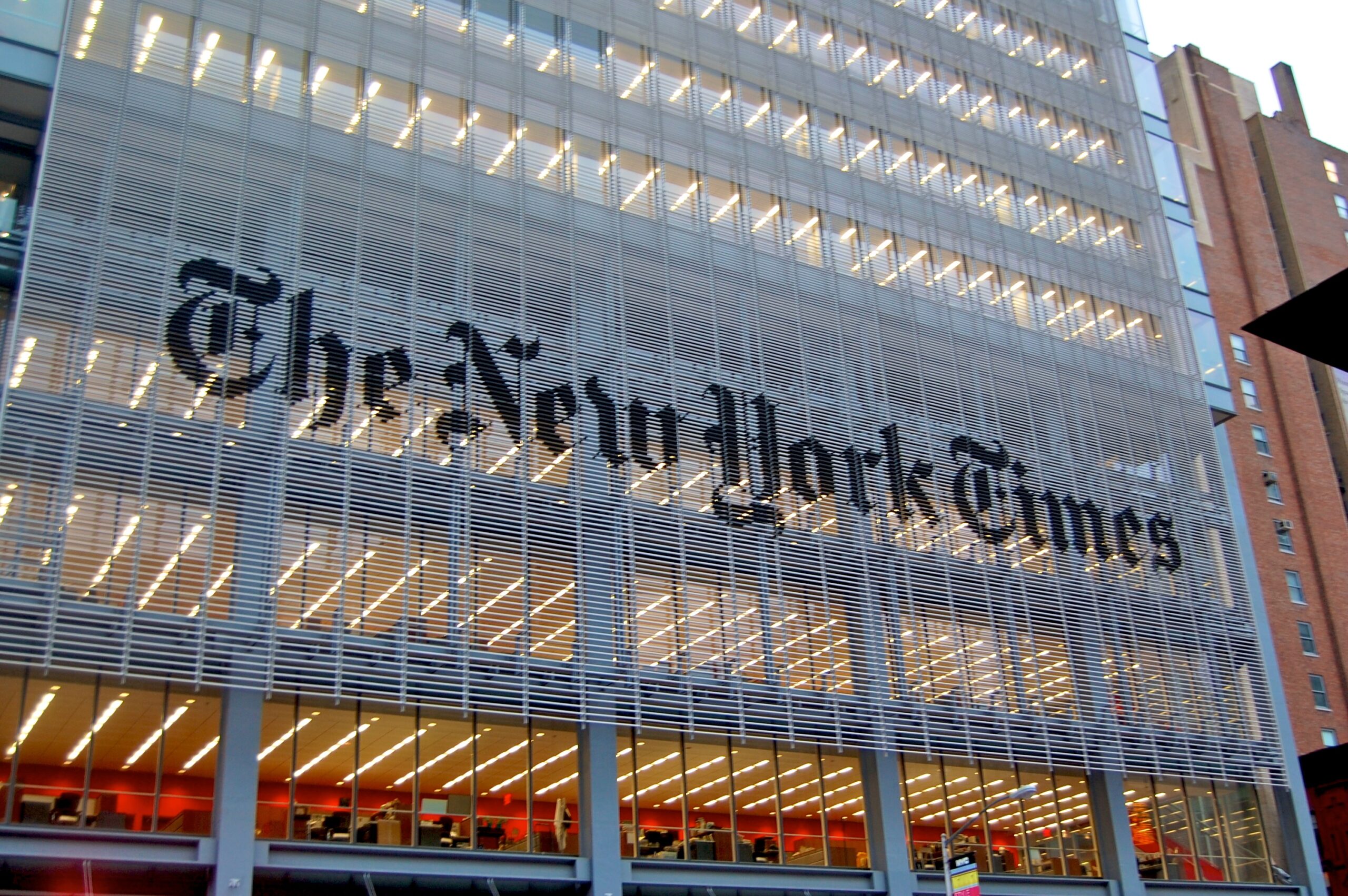Photo: New York Times building, source: Wikimedia Commons.
Published on March 12, 2023 by JNS.
A recent Wall Street Journal essay “The Deepfake Dangers Ahead” highlights the “dangers of AI-generated disinformation, especially from hostile foreign powers, as a growing threat to democracies based on the free flow of ideas.” Deepfake technology allows for “creating a convincing alternate reality” that threatens national security and endangers citizens’ financial safety. For example, “Soldiers might not trust actual orders, and the public may think that genuine scandals and outrages aren’t real.”
Indeed, the power of computers in the hands of malicious actors like Iran, China and Russia may be one of our primary future security threats.
The biggest deep fake, however, is not new. It is the media’s editorialization of news to advance an agenda. As New York Times Magazine writer Nikole Hannah-Jones said, “All journalism is activism.” The media’s traditional role of informing the public has been compromised. Too many in the media think their job is to tell the public what to think and portray their opponents as immoral.
Professor Lauren Wolfe of New York University’s Arthur L. Carter Journalism Institute should be applauded for her honesty. “I’m a Biased Journalist, and I’m Okay with That” goes the title of one of her essays.
“I am biased, and consciously so, regarding certain subjects,” she says. “But when my work calls for me not to be, I work very hard to create unbiased journalism. … Being fair and having a point of view aren’t incompatible. Reporters at The New York Times and elsewhere shouldn’t have to disguise or suppress their views.”
This is the definition of doublespeak. No wonder 86% of Americans say the media is politically biased.
In 2020, New York Times opinion editor Bari Weiss resigned because of a “hostile work environment” created by her woke-oriented colleagues. “A new consensus has emerged in the press,” she said, “but perhaps especially at this paper: truth isn’t a process of collective discovery, but an orthodoxy already known to an enlightened few whose job is to inform everyone else.”
In 2021, National Public Radio’s public editor said that journalists are permitted to engage in political advocacy, ending the prohibition on journalists “personally advocating for controversial or polarizing issues.”
The Guardian’s Nathan Robinson has said, “The Guardian is an explicitly left-leaning paper, and everybody knows it. By contrast, The New York Times is clearly inclined toward Democratic centrism, but it won’t admit it. The editor of the op-ed page says that they strive for ‘viewpoint diversity,’ but it’s clear that he doesn’t mean it.”
When I asked veteran Israeli journalist Akiva Eldar of the left-wing Israeli daily Haaretz if he had any qualms about his paper’s news section advancing a political agenda, he simply told me to read another paper.
NBC news anchor Lester Holt said in 2021, “Fairness is overrated.” Like Wolfe, he deserves credit for his honesty. Three years before Holt’s statement, NBC published an opinion piece that admitted, “Media bias against conservatives is real and part of why no one trusts the news now. … In a recent Gallup poll, 62% of the country believes that the press is biased. … So, when CNN, NBC News, Fox News or another outlet breaks a hard news story, there is a good chance that a large swathe of the public won’t view it as legitimate news. And politicians, right and left, are taking advantage of this.”
During the riots following the death of George Floyd, The New York Times published an op-ed by Sen. Tom Cotton calling for the National Guard to quell the violence. Times journalists claimed without evidence that they were “endangered” by the article, staged a “virtual walkout” and forced the opinion editor to resign. This was the clearest signal that a red line had been crossed.
The issue on which this bias is most pronounced is the Israeli-Palestinian conflict. For example, when Palestinian terrorists are killed, they are almost always referred to as “Palestinians” rather than “terrorists,” implying that they were civilians. But when a Palestinian terrorist recently killed two Israelis, the headline read, “Palestinian kills two Israeli settlers near Nablus.” Calling Jewish victims “settlers” is a transparent attempt to diminish their humanity. This is deliberate manipulation of the truth to advance an agenda.
Today, a generation of news reporters and writers have been indoctrinated in prestige journalism schools, where they are taught that promoting a “correct” narrative is acceptable. As the Associated Press editor Julie Pace said, reporting must “quickly move to provide analysis,” a euphemism for editorialization.
Twenty years ago, Willian McGowan wrote the book Coloring the News. It was a prescient work that documented “how a journalism slanted by good intentions has allowed a narrow multicultural orthodoxy to restrict debate just at the point when information about America’s changing national identity needs to be robust, knowledgeable and honest.”
The Wall Street Journal article on deepfakes cited a possible antidote. In Finland, media literacy programs have been created. Their goal is to help people recognize misinformation as early as preschool.
Whether from the right or the left, media bias has been with us for decades and is undermining democracies. The public knows politicians lie, but they still do not understand the manipulation of news reporting. Since fact-checking sources also tend to be biased, the best temporary solution is to remind everyone to be skeptical of the media and make sure to read and watch multiple news outlets to get a spectrum of views.
Perhaps The New York Times’ motto should be changed to “all the news we think you should know.” That would be more honest.
